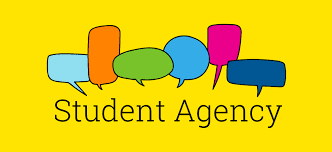
Student Agency in the Classroom
Giving students the power to be involved in their own learning, or “student agency,” in the classroom means giving them ownership of their learning. When students are given choice, they show the following traits:
- Choice and Decision-Making: Students talk about how interested they are in something, what they like, and how they can make their learning more personal all the time. They actively participate in decisions related to education.
- Problem-Solving and Setting Goals: Students set goals that they can reach, think about their success, and change their plans as needed. They are responsible for their own learning and choose how to get around problems based on what they know.
- Autonomy and Independence: Student agency lets students make their own decisions about how to learn. People aren’t just supposed to follow a path; they’re supposed to find their own way, like using a GPS instead of just following road signs.
- Active Engagement: Students are not passive recipients of information. Instead, they actively seek out knowledge, ask questions, and explore topics that interest them.
Choice and Decision Making
What does student choice look like? According to What Student Choice and Agency Actually Look Like article, it provides examples of student’s ability to choose their learning path, the pace at which they progress, and the environment in which they learn, among others:
- Lindsay Senior High School offers learner choice over their mastery level. Lindsay Unified School District (LUSD) operates on a performance-based system, allowing learners (students) to “work at their performance level and [advance] through learning…when they have demonstrated proficiency.” LUSD uses a scoring scale of zero through four to codify proficiency (the core of a three denotes proficiency while a four signifies mastery). Once a student demonstrates proficiency of a learning target, they are able to choose whether they would like to spend more time trying to show mastery, or to move on to the next learning target in their unique learning pathway. Teachers, or “Learning Facilitators” as they are called at LUSD, are able to offer guidance to each student in helping them decide which option is best for their education.
- CICS West Belden enables students to choose resources and assignments through “menus.”CICS West Belden creates “Learner Profiles” for each student to better understand how each student likes to access information, what helps them stay engaged in their learning, and how students like to show what they have learned. Combining this information with formative and summative data, teachers are able to create custom menus for students that include resources that closely match their learning needs. Students are able to choose which resources are most interesting and relevant to them, or even find new resources if none of the menu options meet their needs.
Problem Solving and Setting Goals
Page Tutt, author of 6 Activities That Inspire A Goal-Setting Mindset In Students article, suggests making setting goals visible. Educational consultant Catlin Tucker writes on her blog that pushing students to regularly picture and talk about what they care about and want to work toward boosts their drive and confidence. Having them make vision boards is one way to do this. It’s easy to go from one job to the next in the chaos of daily life, without stopping to think about where we are now and where we want to be one day. What about our students? The same is true, Tucker writes. “I want them to think about what they want to work toward and say what it is.”
Students can use various tools and materials, such as old magazine clippings, to make a collage, or digital programs like Canva or Google Slides. Tucker says the process should start with time and space to “reflect on what is important to them personally and academically.” “What drives you?” or “What do you hope to achieve this year?” are some things you could ask.
Autonomy and Independence
Promoting Independence: Teachers set the stage for promoting independence by giving students the chance to make decisions and take responsibility for their actions. Students should be told to set goals for their learning, keep track of their growth, and think about what they’ve accomplished. Giving kids choices about their education makes them feel responsible and like they own their education. This is according to Empowering Student Agency: Encouraging Independence and Self-Advocacy article.
Active Engagement
From the article Student Agency: Promoting Student Engagement by Kathryn Starke, suggests some specific methods that give students more control over their learning. One important thing to remember is that students only get better at being independent when it is part of their usual lessons. This way of teaching and learning takes some time to get used to for students who are used to standard classrooms where teachers teach and students answer. Both the teacher and the student need to change the way they think about student power. It focuses on the student instead of the teacher, and teachers need to be okay with giving up power. Student autonomy needs to be a regular part of teaching, not just sometimes, if we want to fully engage students and see good results in the learning process.
The first thing that needs to be done to make this happen is to make the classroom a place where questions, creativity, communication, citizenship, critical thought, and working together are valued. The five Cs should be a normal part of a school in the 21st century, and giving students choices ensures they are. Teachers should clearly set learning goals for each student, so that each student knows what they need to do to reach those goals.
It’s also important for the teacher to keep giving comments and helping the student. In fact, this is a great way to get kids fully involved whether they are working alone, with a partner, or in a group. Including discussions and readings that are both current and culturally representative is a great way to get students interested and involved. Sharing, posting, and thinking about student work are also important ways to get them involved. These important parts stress how important it is for students to be independent and in charge.
Using a range of these student agency strategies every day not only gets students involved, but it also lets them make connections, which helps them see things from different angles and learn more about what they are learning. Teachers have seen firsthand how to use technology to get students more interested in learning through virtual and online learning. This doesn’t mean just putting kids in front of a screen or giving them apps. It means planning ahead to use tools that will improve students’ participation, involvement, motivation, and understanding throughout a lesson or unit of study.
